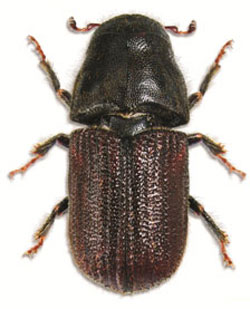The current mountain pine beetle epidemic has been mostly limited to higher-elevation lodge pole pine, primarily west of the continental divide in Routt, Jackson, Grand and Summit Counties. Its recent appearance in lodge pole pine in the western portions of Larimer, Boulder, Gilpin and Clear Creek Counties, has fueled concerns that it may move into ponderosa pine. While past outbreaks of mountain pine beetle in the ’70s and ’90s were primarily in ponderosa pine, forest entomologists are not sure whether the current lodge pole MPB population will move into ponderosa pine at lower and foothills  elevations.
elevations.
Mountain pine beetle is capable of attacking bristlecone, pinyon, limber, ponderosa, Austrian, Scotch and other pines in the urban landscape. Most bark beetle injuries to urban landscape pines have been confirmed as red turpentine beetle, or Ips beetles, both more likely when pines are moderately to severely stressed.
Most urban cases confirmed as mountain pine beetle injury have resulted from cutting and bringing mountain pine beetle -infested firewood from mountain areas, then stacking it around or near landscape pines. The practice of moving firewood many miles from its source should be discouraged. For further information on the mountain pine beetle please see the CSU Extension fact sheet 5.528, Mountain Pine Beetle.



